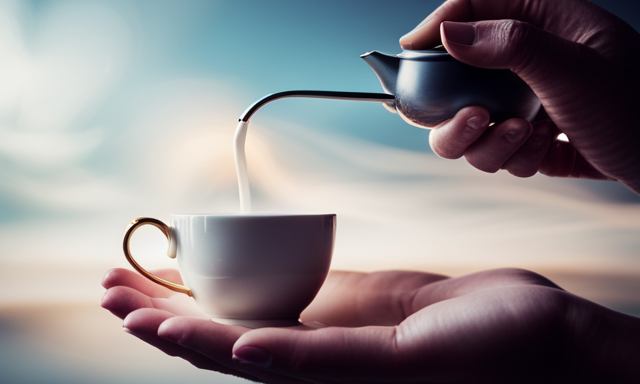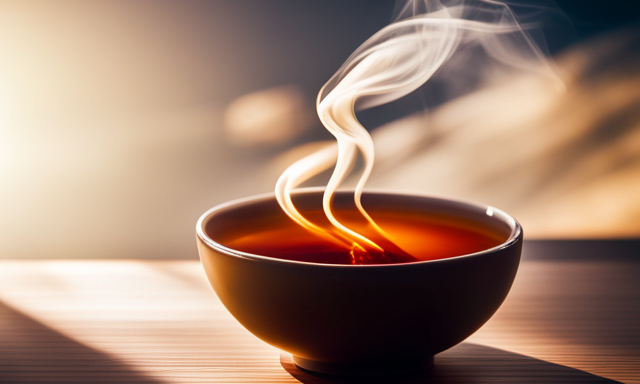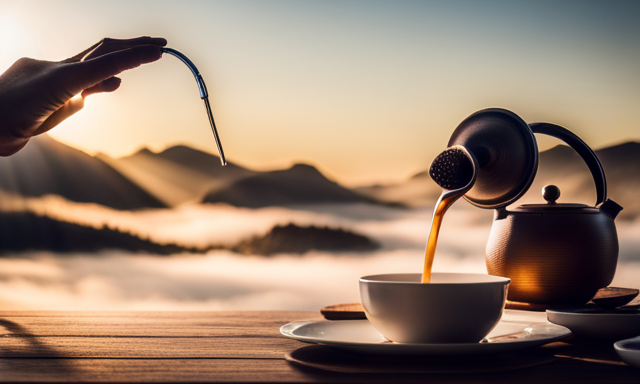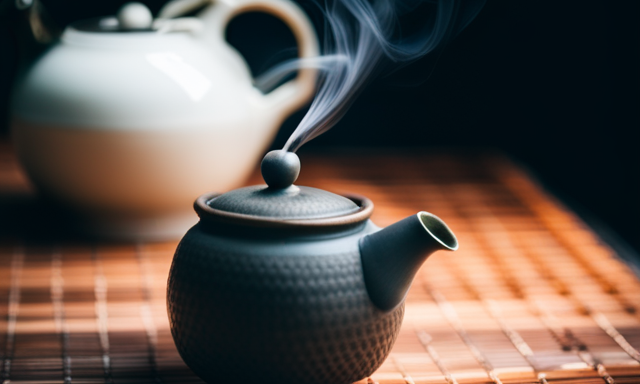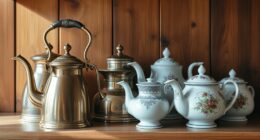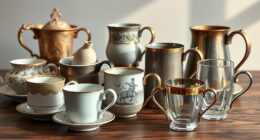Have you ever heard that oolong tea with milk is a beloved and tasty drink that is enjoyed by numerous tea lovers globally?
As a tea lover myself, I have always been intrigued by the unique flavors and aromas that oolong tea offers. The combination of the rich, creamy taste of milk with the smooth, complex notes of oolong tea creates a truly delightful experience for the taste buds.
In this article, I will guide you through the step-by-step process of making oolong tea with milk. From selecting the perfect oolong tea to heating and frothing the milk, I will provide you with all the necessary information to create a perfectly balanced and flavorful cup of oolong tea with milk.
Additionally, I will explore the health benefits of oolong tea and offer tips on storing and reusing oolong tea leaves.
So, grab your favorite oolong tea and let’s embark on a journey to discover the wonderful world of oolong tea with milk!
Key Takeaways
- Oolong tea with milk creates a creamy texture and enhances flavor.
- Selecting high-quality oolong tea is important for a flavorful cup.
- Steeping oolong tea at the right temperature and time ensures a balanced infusion.
- Experiment with different types of milk alternatives for a unique twist.
Introduction to Oolong Tea
Let’s dive into the world of oolong tea, a fascinating and flavorful beverage that’s sure to captivate your taste buds!
Oolong tea is a unique type of tea that falls between black and green tea, offering a distinct flavor profile and a range of health benefits. To fully appreciate the complexity of oolong tea, it’s important to understand its origins and brewing techniques.
Oolong tea originated in China and Taiwan, where it’s been cultivated for centuries. The leaves are partially oxidized, giving it a rich and complex flavor. When brewing oolong tea, it’s crucial to use water that isn’t too hot, around 180°F, and steep it for the appropriate time to bring out the best flavor.
Now that we have a better understanding of oolong tea, let’s move on to selecting the right oolong tea for your taste preferences.
Selecting the Right Oolong Tea
When it comes to choosing the perfect oolong, it’s like finding a rare gem amidst a sea of options. Selecting high-quality tea is crucial to ensure a flavorful cup of oolong.
There are various factors to consider, such as the origin, processing method, and grade of the tea leaves. Oolong teas can range from light and floral to dark and roasted, each offering a unique flavor profile. Some popular oolong teas include Tie Guan Yin, Da Hong Pao, and Oriental Beauty.
It’s important to understand the different flavors of oolong tea to find the one that suits your taste preferences.
Now that we have selected the right oolong tea, let’s move on to preparing the tea leaves for brewing.
Preparing the Tea Leaves
When preparing oolong tea, it’s crucial to measure the correct amount of tea leaves to achieve the desired flavor.
Rinsing the leaves before steeping can enhance the taste of the tea by removing any impurities.
Additionally, steeping the leaves at the right temperature and time ensures the perfect balance of flavors.
Measure the correct amount of tea leaves
To achieve the perfect balance of flavors, you’ll want to carefully measure the precise amount of tea leaves for your oolong tea with milk. Measuring tea leaves accurately is crucial as it ensures the right tea to water ratio, which directly impacts the taste of the final brew.
The general guideline is to use 2 grams of tea leaves for every 8 ounces of water. However, you may need to adjust this depending on your personal preference. I recommend using a kitchen scale to measure the tea leaves precisely. This will help you achieve consistent results every time you make oolong tea with milk.
Once you have measured the correct amount of tea leaves, you can move on to the next step of rinsing the leaves for better flavor.
Rinse the leaves for better flavor
After accurately measuring the precise amount of tea leaves for your oolong tea with milk, it is essential to rinse the leaves to enhance the flavor profile. The rinse technique involves pouring hot water over the leaves and quickly discarding it. This step removes any impurities and dust, resulting in a cleaner taste. Additionally, rinsing the leaves helps to awaken their natural aromas and flavors, allowing them to fully infuse into the tea. It also preheats the teapot or cup, which helps to maintain the optimal temperature during steeping. By incorporating this simple step into your tea-making routine, you can experience the benefits of rinsing firsthand – a smoother, more balanced cup of oolong tea with milk. Now, let’s move on to the next section and learn how to steep the leaves at the right temperature and time.
Steep the leaves at the right temperature and time
Now, let’s dive into the art of steeping the leaves just right, allowing them to dance and release their full potential of flavors and aromas.
When it comes to oolong tea, optimal brewing techniques are crucial to achieve the perfect cup. One of the key factors to consider is the water temperature. Oolong tea leaves require a slightly higher temperature than other teas to fully develop their complex flavors. The ideal water temperature for steeping oolong tea is around 190°F (88°C). This temperature allows the leaves to slowly unfurl and release their delicate essence without becoming bitter.
Steeping oolong tea for about 3-5 minutes will result in a well-balanced infusion. The combination of the right temperature and steeping time ensures a harmonious blend of floral, fruity, and earthy notes.
Now, let’s move on to the next step of heating and frothing the milk.
Heating and Frothing the Milk
To make a delicious cup of oolong tea with milk, the first step is heating the milk to the desired temperature. I usually aim for a warm but not scalding temperature, around 140-160 degrees Fahrenheit.
Once the milk is heated, the next step is frothing it to achieve a creamy texture. This can be done using a handheld milk frother or by vigorously whisking the milk in a saucepan until it becomes frothy and velvety.
Heat the milk to the desired temperature
Once the milk reaches the desired temperature, it’s time to move on to the next step in making oolong tea with milk. When heating the milk, there are various techniques you can use to achieve the perfect temperature. You can heat the milk on the stovetop, using a double boiler or a small saucepan. Alternatively, you can also use a microwave-safe container and heat the milk in the microwave. It’s important to note that different types of milk alternatives may require different heating techniques, so be sure to follow the instructions on the packaging.
To help you visualize the different options for heating the milk, here is a table comparing the stovetop method, double boiler method, and microwave method:
| Heating Technique | Pros | Cons |
|---|---|---|
| Stovetop | Quick and efficient | Requires constant monitoring |
| Double Boiler | Gentle heating, less risk of scorching | Takes longer than other methods |
| Microwave | Fast and convenient | Can be difficult to control the temperature precisely |
Now that the milk is heated to perfection, let’s move on to frothing it for a creamy texture.
Froth the milk for a creamy texture
Get ready to create a velvety smooth texture by frothing the warm milk. Frothing the milk is an essential step in making oolong tea with milk as it adds a creamy and luxurious touch to the beverage.
There are several frothing techniques you can use, such as using a handheld frother, a milk frother, or even a blender. If you prefer a non-dairy alternative, you can use almond milk, soy milk, or oat milk, which can also be frothed to perfection.
To froth the milk, start by heating it to the desired temperature, then immerse the frother into the milk and move it in an up-and-down motion until it becomes foamy. This frothed milk will blend beautifully with the infused tea, creating a delightful and indulgent drink.
Now, let’s move on to the next step of infusing the tea and milk for a flavorful combination.
Infusing the Tea and Milk
First, steep the oolong tea leaves in hot water, allowing the rich aroma to fill your cup. As the tea infuses, you’ll notice the leaves unfurling, releasing their flavors into the water.
Now, it’s time to infuse the tea with milk to create a creamy texture. Here are some infusing techniques to consider:
- Slowly pour warm milk into the tea, allowing them to blend harmoniously.
- Gently stir the tea and milk together, creating a smooth and velvety consistency.
- For a bolder flavor, add a splash of condensed milk or coconut milk instead.
- Experiment with milk alternatives like almond milk or soy milk for a unique twist.
By incorporating these techniques, you’ll achieve a delightful fusion of tea and milk.
Now, let’s explore some optional additions and variations to enhance your oolong tea experience.
Optional Additions and Variations
When it comes to infusing oolong tea with milk, there are several optional additions and variations that can enhance the flavor and experience.
To sweeten the tea, I recommend adding a touch of honey or sugar, which can complement the earthy notes of the oolong.
For a delightful twist, try incorporating spices like cinnamon or cardamom, which can add warmth and depth to the drink.
Lastly, don’t be afraid to experiment with different types of milk, such as almond, coconut, or even condensed milk, to find the perfect balance of creaminess and taste.
Sweeten with honey or sugar
To enhance the flavor of your oolong tea with milk, you can sweeten it with either honey or sugar, depending on your personal preference. Sweetening your tea can add a delightful touch of sweetness and balance out the flavors. Here are some options to consider:
-
Sweeten with agave nectar: Agave nectar is a natural sweetener that can add a subtle sweetness to your oolong tea with milk. It has a lower glycemic index compared to sugar, making it a healthier alternative.
-
Use maple syrup as a sweetener: Maple syrup not only adds sweetness but also brings a rich, earthy flavor to your tea. It pairs well with the nuttiness of oolong tea and creates a delicious combination.
-
Experiment with different amounts: Adjust the sweetness according to your taste. Start with a small amount of honey or sugar, and gradually add more until you achieve your desired level of sweetness.
-
Try flavored honey: Infused honey, such as lavender or cinnamon honey, can add an extra layer of flavor to your tea. It’s a unique and enjoyable way to sweeten your oolong tea with milk.
-
Consider using brown sugar: Brown sugar has a distinct molasses flavor that can complement the robustness of oolong tea. It adds depth and complexity to your cup.
By sweetening your oolong tea with milk, you can create a well-rounded and enjoyable beverage. Once you’ve added your preferred sweetener, you can move on to adding spices like cinnamon or cardamom for an extra burst of flavor.
Add spices like cinnamon or cardamom
Enhance the sensory experience of your oolong tea with a tantalizing blend of cinnamon or cardamom spices.
These aromatic spices not only add a delightful flavor to your tea but also bring numerous health benefits. Cinnamon, known for its warm and sweet taste, is rich in antioxidants and has anti-inflammatory properties. Cardamom, with its unique and fragrant aroma, aids digestion and helps in detoxification.
By incorporating these spices into your oolong tea, you not only elevate its taste but also boost your overall well-being. So go ahead, sprinkle a pinch of cinnamon or a dash of cardamom into your tea and experience a symphony of flavors.
Now, let’s move on to the next step and experiment with different types of milk to further enhance your oolong tea.
Experiment with different types of milk
After experimenting with spices like cinnamon or cardamom, it’s time to explore the world of different types of milk to enhance your oolong tea experience.
There are numerous milk alternatives available, each offering a unique flavor and texture. Some popular options include almond milk, coconut milk, and oat milk. These alternatives can add a subtle nuttiness, creaminess, or sweetness to your oolong tea.
To achieve a frothy texture, you can use a frother to whisk the milk before adding it to your tea. Alternatively, you can heat the milk gently on the stove and use a handheld frother to create a velvety foam.
Experimenting with different milk alternatives and frothing techniques allows you to customize your oolong tea with milk to your taste preferences.
Now, let’s move on to the next step of serving and enjoying oolong tea with milk.
Serving and Enjoying Oolong Tea with Milk
When serving oolong tea with milk, I pour the steeped tea into a teacup or mug, allowing the creamy and aromatic flavors to meld together.
To add a touch of elegance, I garnish the top with a sprinkle of tea leaves, enhancing the visual appeal.
As I take a sip, I savor the harmonious blend of the smooth milk and the robust oolong, creating a truly delightful and indulgent experience.
Pour the tea into a teacup or mug
Pour the fragrant oolong tea into a cozy teacup, gently swirling the milky goodness into the rich, amber liquid.
- Use a kettle or stovetop to heat water to the desired temperature, usually around 195°F to 205°F.
- Experiment with different milk choices such as almond milk, soy milk, or coconut milk for a unique twist on traditional oolong tea.
- Choose your favorite teacup or mug to enhance the tea-drinking experience.
- Consider the size of the cup, ensuring it’s large enough to accommodate the desired amount of tea and milk.
- Opt for a cup with a handle, allowing for easy gripping and sipping.
Now that the tea is poured, it’s time to move on to the next step: garnish with a sprinkle of tea leaves.
Garnish with a sprinkle of tea leaves
To add a touch of elegance to your tea, simply sprinkle a few tea leaves on top, like a delicate dusting of fairy magic. This garnish not only enhances the visual appeal of your oolong tea with milk, but it also adds a subtle hint of flavor that complements the rich taste of the drink.
You can choose from a variety of garnish ideas to suit your taste and preference. Some popular options include a sprinkle of fresh mint leaves, a dusting of cinnamon powder, or even a pinch of grated nutmeg.
For those looking for alternative milk options, you can experiment with almond milk, coconut milk, or soy milk to create a creamy and luscious texture.
Sip and savor the creamy and aromatic flavors that’ll transport you to a state of pure bliss.
Sip and savor the creamy and aromatic flavors
Indulge in the velvety smoothness and heavenly aroma of these creamy and aromatic flavors. Sip and savor the delightful combination of oolong tea and milk, creating a truly indulgent experience.
The addition of milk adds a creamy richness to the tea, enhancing its natural sweetness. You can experiment with different types of milk alternatives to suit your taste preferences. Whether you prefer the silky texture of almond milk or the nutty undertones of coconut milk, there are endless possibilities to explore. Each variation offers a unique twist, allowing you to create your own personalized oolong tea with milk.
As you take each sip, the flavors dance on your palate, tantalizing your senses.
Now, let’s delve into the health benefits of oolong tea, and discover how this delightful beverage can nourish your body and mind.
Health Benefits of Oolong Tea
Oolong tea has a range of health benefits that make it a popular choice for tea lovers like me. One of the key benefits is its antioxidant properties, which help to protect the body against free radicals and oxidative stress.
Not only that, but oolong tea also boosts metabolism and aids in weight loss, making it a great addition to a healthy lifestyle.
Additionally, it promotes heart health by reducing the risk of heart disease and lowering cholesterol levels.
Antioxidant properties
Did you know that drinking oolong tea with milk can increase your intake of antioxidants? This can help fight against harmful free radicals, which can cause cellular damage and lead to various health issues. Antioxidants play a crucial role in preventing diseases by neutralizing these free radicals. Oolong tea contains polyphenols, a type of antioxidant that can help protect against chronic diseases such as heart disease, diabetes, and certain types of cancer. These powerful antioxidants not only support overall health but also contribute to a youthful appearance and healthy skin.
Additionally, the combination of oolong tea and milk creates a delightful creamy texture and enhances the flavor. This makes it a refreshing and enjoyable beverage. Moving on to the next section about ‘boosts metabolism and aids weight loss,’ oolong tea has even more to offer in terms of health benefits.
Boosts metabolism and aids weight loss
After learning about the antioxidant properties of oolong tea, let’s delve into another benefit – how it can boost metabolism and aid in weight loss. As a tea enthusiast, I’ve discovered that oolong tea is not only delicious but also a great companion on my wellness journey.
The combination of oolong tea and milk creates a creamy and indulgent beverage that can power up your energy levels while improving digestion. To maximize the benefits, consider adding a dash of cinnamon, which helps regulate blood sugar levels and curb cravings. Additionally, a squeeze of fresh lemon juice can enhance the tea’s metabolism-boosting effects.
The caffeine in oolong tea increases fat oxidation and can aid in weight loss when combined with a balanced diet and exercise routine.
Now, let’s explore how oolong tea promotes heart health and supports overall well-being.
Promotes heart health
Indulging in a cup of this aromatic beverage can provide a boost to your cardiovascular health, helping to keep your heart strong and your blood flowing smoothly. Oolong tea has been found to offer numerous heart health benefits, according to research.
It contains antioxidants called catechins that may help reduce the risk of heart disease by preventing the oxidation of LDL cholesterol. Additionally, oolong tea has been shown to lower blood pressure levels, which is crucial in maintaining a healthy heart. Its polyphenols may also improve endothelial function, promoting better blood vessel health.
By incorporating oolong tea into your routine, you can take a proactive step towards maintaining a healthy heart.
Now, let’s move on to the next section and learn how to store and reuse oolong tea leaves.
Storing and Reusing Oolong Tea Leaves
When it comes to storing and reusing oolong tea leaves, I always make sure to store them in an airtight container to preserve their freshness and flavor. This helps to maintain the quality of the leaves and ensures that they don’t lose their aroma over time.
Additionally, I find that re-infusing the leaves for multiple cups of tea is a great way to get the most out of them and enjoy their unique taste for longer.
Store in an airtight container to preserve freshness
Seal in the exquisite flavor of your oolong tea by storing it in an airtight container, allowing the freshness to linger and enchant with each sip. Properly preserving tea freshness is essential to enjoy the full range of flavors that oolong tea has to offer.
Storing your tea leaves in an airtight container helps to prevent the intrusion of moisture, light, and other odors that can compromise its quality. By doing so, you ensure that the delicate notes and aromas of the tea are preserved, resulting in a more enjoyable experience. Additionally, storing oolong tea properly extends its shelf life, allowing you to savor its goodness for a longer period.
Now that you have your oolong tea safely stored, let’s move on to the next step: re-infusing the leaves for multiple cups of tea.
Re-infuse the leaves for multiple cups of tea
To keep the flavorful journey going, simply steep the leaves again and again for multiple cups of tea. Re-infusing tea leaves is a great way to maximize the flavor and get the most out of your oolong tea.
After the first steeping, don’t toss out the leaves just yet. Instead, give them a quick rinse with hot water to awaken their flavors once again. Then, steep the leaves for a slightly longer time than before to extract every last bit of taste.
Each re-infusion will have a slightly different flavor profile, allowing you to experience the complexity of the oolong tea. This process can be repeated two or three times, depending on your preference and the quality of the leaves.
Now, let’s explore other oolong tea recipes and pairings to continue our tea adventure.
Exploring Other Oolong Tea Recipes and Pairings
Try experimenting with different flavor pairings, such as adding a dash of honey to your oolong tea with milk for a delightful burst of sweetness that perfectly complements the rich and earthy notes of the tea.
Another way to explore the versatility of oolong tea is by incorporating it into tea-infused desserts. Imagine a creamy oolong tea-infused ice cream or a delicate oolong tea-infused cake. These desserts not only enhance the flavors of the oolong tea but also provide a unique twist to traditional desserts.
Additionally, consider pairing oolong tea with cheese for a surprising and delightful combination. The slightly sweet and floral notes of oolong tea can beautifully complement the creamy and tangy flavors of various cheeses. Experiment with different cheese varieties like brie or gouda to find your perfect pairing.
Frequently Asked Questions
Can I use any type of milk to make oolong tea with milk?
Yes, you can use various types of milk like cow’s milk, almond milk, or soy milk to make oolong tea with milk. Adding milk enhances the flavor and provides a creamy texture to the tea.
How long should I heat the milk for before frothing it?
I usually heat the milk for about 1 minute before frothing it. This ensures that it reaches the perfect temperature for a creamy and frothy texture. When frothing, I use a handheld frother for best results.
What are some popular optional additions or variations to oolong tea with milk?
Popular milk alternatives for oolong tea include almond, soy, and coconut milk. Adding milk to oolong tea can enhance its flavor and provide health benefits such as improved digestion and increased calcium intake.
Can I make oolong tea with milk using tea bags instead of loose tea leaves?
Yes, you can make oolong tea with milk using tea bags instead of loose tea leaves. This is a convenient alternative for those who prefer the benefits of adding milk to their oolong tea.
Can I store and reuse the milk-infused oolong tea leaves for future use?
Storing milk-infused oolong tea leaves is not recommended as the milk can spoil and affect the flavor. Reusing tea leaves for future use is possible, but they may not yield the same flavor profile.
Conclusion
In conclusion, making oolong tea with milk is a delightful way to savor the rich flavors of this unique tea. By carefully selecting the right oolong tea and following the proper steps to prepare it, you can create a creamy and fragrant beverage that will surely satisfy your taste buds.
Remember, practice makes perfect, so don’t be afraid to experiment with different infusions and pairings. Just remember, the proof is in the pudding, or in this case, the tea cup.
So go ahead and indulge in this delightful tea concoction and enjoy the many health benefits it has to offer.

